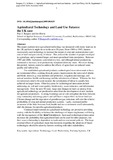JavaScript is disabled for your browser. Some features of this site may not work without it.
| dc.contributor.author | Burgess, Paul J. | - |
| dc.contributor.author | Morris, Joe | - |
| dc.date.accessioned | 2011-09-29T17:37:23Z | |
| dc.date.available | 2011-09-29T17:37:23Z | |
| dc.date.issued | 2009-12-31T00:00:00Z | - |
| dc.identifier.citation | Paul J. Burgess and Joe Morris, Agricultural technology and land use futures: The UK case, Land Use Policy, Volume 26, Supplement 1, December 2009, Pages S222-S229. | |
| dc.identifier.issn | 0264-8377 | - |
| dc.identifier.uri | http://dx.doi.org/10.1016/j.landusepol.2009.08.029 | - |
| dc.identifier.uri | http://dspace.lib.cranfield.ac.uk/handle/1826/6231 | |
| dc.description.abstract | This paper explores how agricultural technology has interacted with recent land use in the UK and how it might do so in the next 50 years. From 1960 to 1985, farmers successfully used technology to increase the output of crop and animal products per unit of land and particularly of labour. This reduced the number of people employed in agriculture, and promoted larger and more specialised farm enterprises. Between 1985 and 2006, food prices were relatively low, and although labour productivity continued to increase, land productivity remained relatively static. However during this period, farmers started to address the effects of agriculture on reduced water quality and habitat loss. For established agricultural products, technological innovation tends to have an incremental effect, working through genetic improvement, the removal of abiotic and biotic stress (e.g. crop nutrition and protection, irrigation and drainage, and animal nutrition, health and housing) and the substitution of labour. Whereas the first two processes tend to be scale-neutral, the substitution of labour is usually easiest to achieve on larger farms. Other key areas for technological innovation include addressing air, soil and water quality, biodiversity, waste reduction, and information management. Over the next 50 years, large step-changes in land use arising from agricultural technology are predicted to arise from the development of new markets for agricultural products. A strong bioenergy sector will strengthen the links between crop commodity and energy prices and will have a major effect on future land use. Climate change and the regulation of greenhouse gas emissions will alter the relative profitability of crop and animal production systems. Lastly, increased public awareness of the links between food, health and the environment could substantially shift the demand for specific agricultural products. Continual improvements in agricultural technology are pivotal to providing society with the flexibility to balance the challenges of improving human well-being with the management of the planet’s ecosystem. Increased technological innovation increases the probability that agricultural land can be used for other purposes, but the exact relationship is dependent on trade and environmental policies. The large external effects of agriculture mean that decisions regarding the adoption of future technologies should be taken by farmers working with other stakeholders. © 2009 Queen’s Printer and Controller of HMSO. Published by Elsevier Ltd. All rig | en_UK |
| dc.language.iso | en_UK | - |
| dc.publisher | Elsevier Science B.V., Amsterdam. | en_UK |
| dc.rights | NOTICE: this is the author’s version of a work that was accepted for publication in Land Use Policy. Changes resulting from the publishing process, such as peer review, editing, corrections, structural formatting, and other quality control mechanisms may not be reflected in this document. Changes may have been made to this work since it was submitted for publication. A definitive version was subsequently published in Land Use Policy, VOL 26, Supplement 1, (2009) DOI: 10.1016/j.landusepol.2009.08.029 | |
| dc.subject | Agriculture Technology Land Productivity Farming systems UK genetically-modified crops productivity growth sustainability biodiversity management britain england impacts systems wheat | en_UK |
| dc.title | Agricultural technology and land use futures: The UK case | en_UK |
| dc.type | Article | - |
Files in this item
This item appears in the following Collection(s)
-
Staff publications (SAS) [906]
